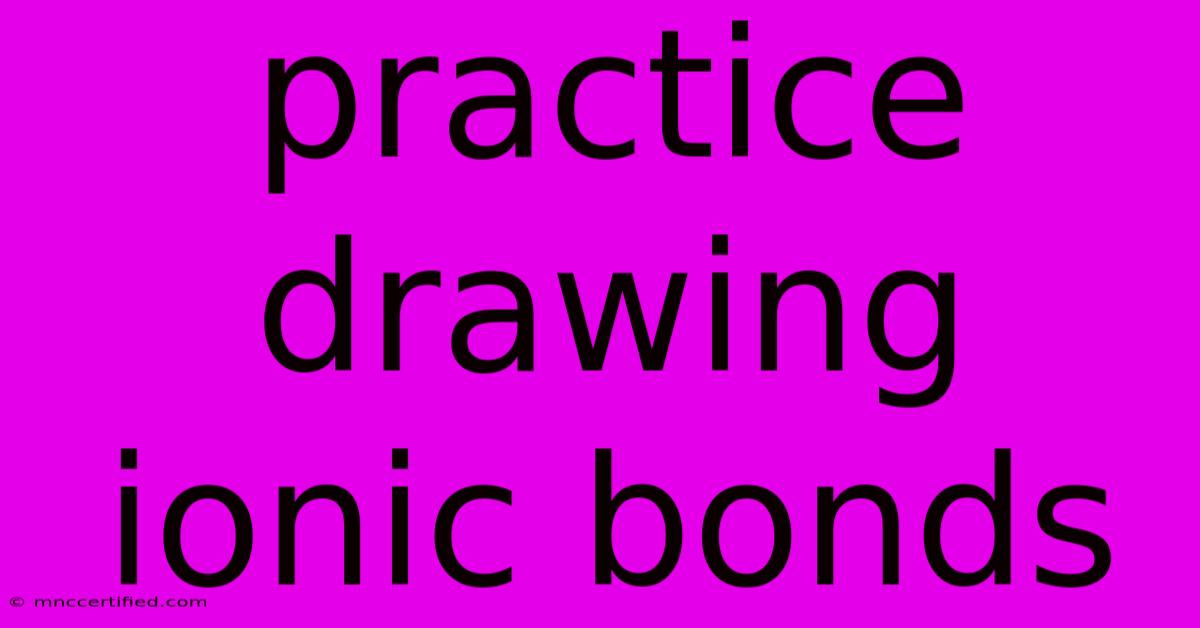Practice Drawing Ionic Bonds

Table of Contents
Practice Drawing Ionic Bonds: A Step-by-Step Guide
Ionic bonds, the electrostatic forces holding oppositely charged ions together, are fundamental to chemistry. Mastering how to draw them is crucial for understanding chemical structures and reactions. This comprehensive guide provides a step-by-step approach to drawing ionic bonds, incorporating various examples and tips to enhance your understanding and skill.
Understanding the Basics of Ionic Bonds
Before diving into drawing, let's solidify our understanding of ionic bonding. Ionic bonds form between metals and nonmetals. Metals readily lose electrons to achieve a stable electron configuration (often an octet), forming positively charged cations. Nonmetals readily gain electrons to achieve a stable configuration, forming negatively charged anions. The electrostatic attraction between these oppositely charged ions constitutes the ionic bond.
Key Concepts to Remember:
- Electronegativity: The tendency of an atom to attract electrons towards itself in a chemical bond. Large differences in electronegativity between atoms favor ionic bonding.
- Valence Electrons: Electrons in the outermost shell of an atom, participating in chemical bonding.
- Octet Rule: Atoms tend to gain, lose, or share electrons to achieve a full outer shell of eight electrons (except for hydrogen and helium, which aim for two).
Step-by-Step Guide to Drawing Ionic Bonds
Let's illustrate the process with the example of sodium chloride (NaCl), commonly known as table salt.
Step 1: Identify the Elements and Their Charges
Sodium (Na) is an alkali metal in group 1, readily losing one electron to form a +1 cation (Na⁺). Chlorine (Cl) is a halogen in group 17, readily gaining one electron to form a -1 anion (Cl⁻).
Step 2: Determine the Ratio of Ions
To achieve charge neutrality in the compound, the number of positive charges must equal the number of negative charges. In NaCl, one Na⁺ ion balances one Cl⁻ ion.
Step 3: Draw the Ions
Represent each ion using its chemical symbol. Enclose the symbol in square brackets and indicate the charge as a superscript.
[Na⁺] [Cl⁻]
Step 4: Show the Ionic Bond
Draw a line connecting the cation and anion to represent the electrostatic attraction between them. This line symbolizes the ionic bond.
[Na⁺] — [Cl⁻]
Practice Examples: Drawing More Complex Ionic Compounds
Let's tackle more complex examples:
Example 1: Magnesium Oxide (MgO)
Magnesium (Mg) loses two electrons to form Mg²⁺, while oxygen (O) gains two electrons to form O²⁻. The ratio is 1:1.
[Mg²⁺] — [O²⁻]
Example 2: Aluminum Chloride (AlCl₃)
Aluminum (Al) loses three electrons to form Al³⁺. Chlorine (Cl) gains one electron to form Cl⁻. To balance the charges, we need three Cl⁻ ions for each Al³⁺ ion.
[Al³⁺] — [Cl⁻] — [Cl⁻] — [Cl⁻] (Note: You can also represent this as a formula unit: AlCl₃)
Tips for Success in Drawing Ionic Bonds
- Use Clear Symbols and Charges: Ensure your symbols are legible, and charges are clearly indicated.
- Maintain Proper Ratios: Accurate representation of ion ratios is vital for correct depiction of the compound.
- Practice Regularly: Consistent practice with various examples will solidify your understanding and improve your drawing skills.
- Utilize Online Resources: Explore interactive simulations and online tutorials to reinforce your learning. Search for "ionic bond simulator" or "ionic bonding practice problems" to find helpful resources.
Beyond the Basics: Exploring More Advanced Concepts
Once you've mastered the fundamentals, you can explore more advanced concepts, such as:
- Crystal Lattice Structures: Understanding how ions arrange themselves in three-dimensional structures.
- Polyatomic Ions: Drawing ionic bonds involving ions containing multiple atoms (e.g., sulfate, nitrate).
- Predicting Ionic Compound Properties: Relating ionic bond strength to properties like melting point and solubility.
By following this guide and practicing diligently, you'll develop proficiency in drawing ionic bonds and enhance your overall understanding of chemical bonding. Remember to utilize online resources and practice regularly to build a strong foundation in chemistry.

Thank you for visiting our website wich cover about Practice Drawing Ionic Bonds. We hope the information provided has been useful to you. Feel free to contact us if you have any questions or need further assistance. See you next time and dont miss to bookmark.
Featured Posts
-
Dunfermline Homebase Investor Deadline
Nov 30, 2024
-
Tv Star Mulhern In Hospital After Pizza Event
Nov 30, 2024
-
Gold Bond Lotion Travel Size
Nov 30, 2024
-
Assisted Dying Bill Dr Uks Response
Nov 30, 2024
-
Jeanty Boise States Shirtless Practice
Nov 30, 2024